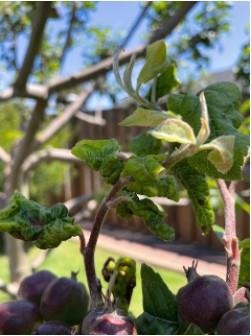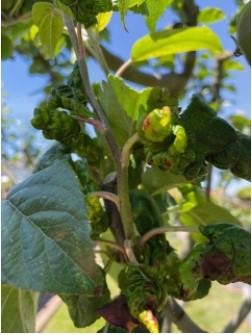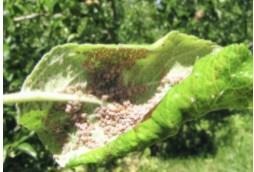By Tom Schrader
Aphids are the most frequent pests of orchards. You may notice the apple tree leaves are curled up, and when you open the leaves, you'll see a mass of small gray insects. The gray aphids are common everywhere. Their bodies are covered with small gray scales with ash bloom.
Life Cycle
Most aphids in California's mild climate reproduce asexually throughout most or all year with adult females giving birth to live offspring—often as many as 12 per day—without mating. Some species produce sexual forms that mate and produce eggs in fall or winter, providing a hardier stage to survive harsh weather and the absence of foliage on deciduous plants. When the weather is warm, many species of aphids can develop from newborn nymph to reproducing adult in seven to eight days. Because each adult aphid can produce up to 80 offspring in a matter of a week, aphid populations can increase with great speed.

Damage
The aphid sucks out the juice from the leaves, damages the young shoots and leaves behind a sticky sweet substance (honeydew) that attracts ants. After they're done, the leaves turn yellow, twist and die. The leaves are left with dark spots, plaque and mold. Aphids on apple tree seedlings cause twigs to wither and stop growth development. However, they seldom kill a mature plant.
Monitor
Check your plants regularly for aphids—at least twice a week when plants are growing rapidly—in order to catch infestations early, so you can knock or hose them off or prune them out. Many species of aphids cause the greatest damage in late spring when temperatures are warm but not hot (65°-80°F). For aphids that cause leaves to curl, once aphid numbers are high and they have begun to distort leaves, it's often difficult to control these pests, because the curled leaves shelter aphids from insecticides and natural enemies.
Ants are often associated with aphid populations, especially on trees and shrubs, and frequently are a clue that an aphid infestation is present. If you see large numbers of ants climbing your tree trunks, check higher up the tree for aphids or other honeydew-producing insects that might be on limbs and leaves. To protect their food source, ants ward off many predators and parasites of aphids. Managing ants is a key component of aphid management.

Biological Control
Natural enemies can be very important for controlling aphids. Many predators feed on aphids. The most well-known are lady beetle adults and larvae, lacewing larvae, soldier beetles, and fly larvae. Naturally occurring predators work best, especially in garden and landscape situations. Applying commercially available lady beetles (the convergent lady beetle, Hippodamia convergens) may give some temporary control when properly handled, although most of them will disperse from your yard within a few days.
Among the most important natural enemies are various species of parasitic wasps that lay their eggs inside aphids. The skin of the parasitized aphid turns crusty and golden brown, a form called a mummy. The generation time of most parasites is quite short when the weather is warm, so once you begin to see mummies on your plants, the aphid population is likely to be reduced substantially within a week or two.
In some situations, ants tend aphids and feed on the honeydew aphids excrete. At the same time, ants protect the aphids from natural enemies. If you see ants crawling up aphid-infested trees or woody
plants, put a band of sticky material (e.g., Tanglefoot) around the trunk to prevent ants from climbing up. Prune out other ant routes such as branches touching buildings, the ground, or other trees.
Cultural Control
Where aphid populations are localized on a few curled leaves or new shoots, the best control may be to prune out these areas and dispose of them. In large trees, some aphids thrive in the dense inner canopy; pruning out these areas can make the habitat less suitable.
High levels of nitrogen fertilizer favor aphid reproduction, so never use more nitrogen than necessary. Instead, use a less soluble form of nitrogen and apply it in small portions throughout the season rather than all at once. Slow-release fertilizers such as organic fertilizers or urea-based time-release formulations are best.

Chemical Control
When considering whether to apply insecticides for aphid control, remember that most larger plants can tolerate light to moderate levels of aphids with little damage. Larger aphid populations often rapidly decline due to biological control or when hot temperatures arrive. Often a forceful spray of water or water-soap solution, even on large street trees, when applied with appropriate equipment, will provide enough control.
If insecticides are needed, insecticidal soaps and oils are the best choices for most situations. Oils may include petroleum-based horticultural oils or plant-derived oils such as neem or canola oil. These products kill primarily by smothering the aphid, so thorough coverage of infested foliage is required. Apply these materials with a high volume of water, usually a 1 to 2% oil solution in water, and target the underside of leaves as well as the top. Soaps, neem oil, and horticultural oil kill only aphids present on the day they are sprayed, so applications may need to be repeated. Although these materials can kill some natural enemies that are present on the plant and hit by the spray, they leave no toxic residue, so they don't kill natural enemies that migrate in after the spray.
Also, don't use soaps or oils on water-stressed plants or when the temperature exceeds 90°F. These materials may be phytotoxic to some plants, so check labels and test the materials on a portion of the foliage several days before applying a full treatment.
Supreme- or superior-type oils will kill overwintering eggs of aphids on fruit trees if applied as a delayed-dormant application just as eggs are beginning to hatch in early spring. These treatments won't give complete control of aphids and probably aren't justified for aphid control alone but will also control soft scale insects if they are a problem. Common aphid species controlled with these types of oils include the woolly apple aphid, green apple aphid, rosy apple aphid, mealy plum aphid, and black cherry aphid.
Source : ucanr.edu